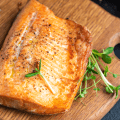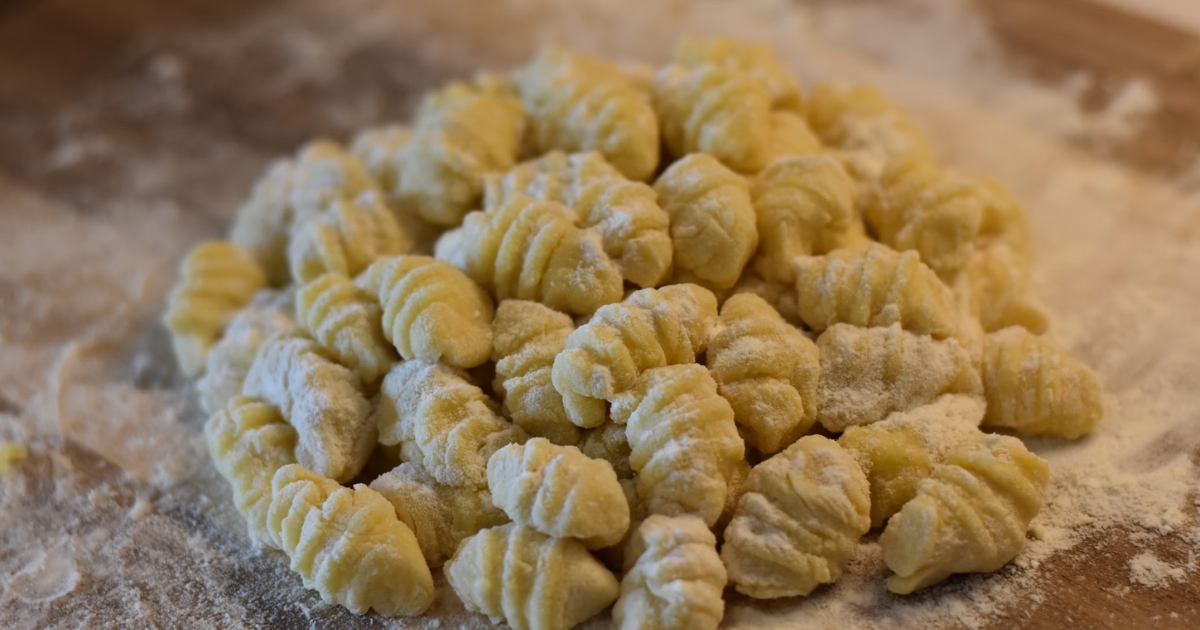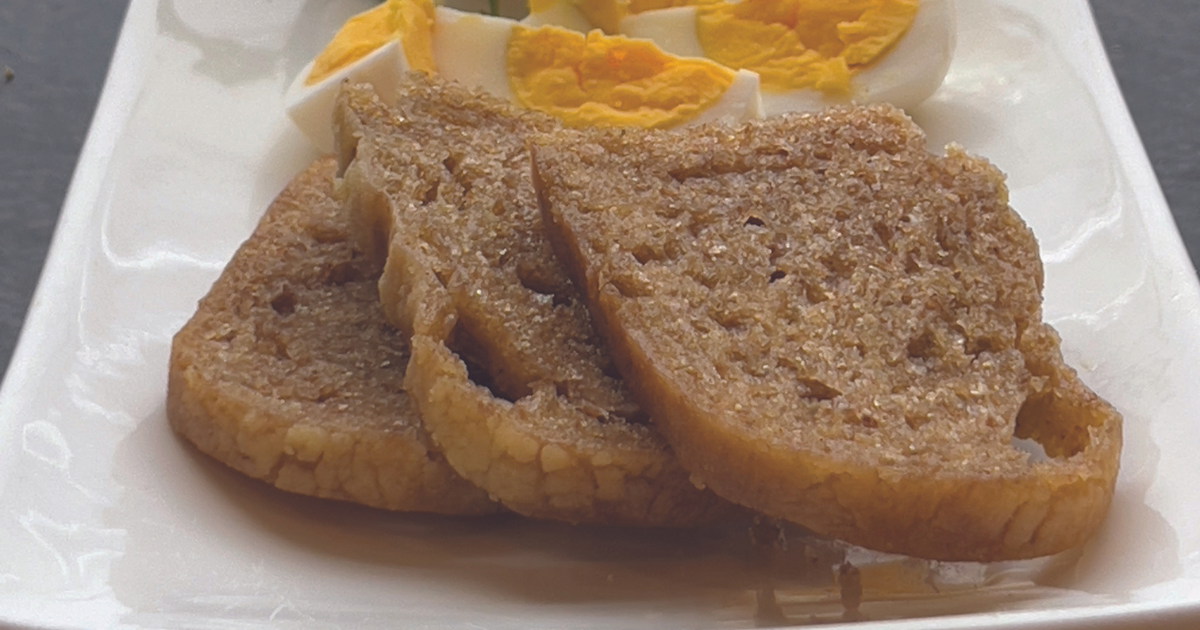Chef ILona Daniel makes alfresco dining easy with this fresh summertime menu.

The simple menus I create on these days call for pulling out the platters and serving family-style. The best time to dine outside is just as the sun begins to set and the light turns golden. Some of my favourite memories are these magical summer evenings filled with laughter, great food and cool sips. I hope these recipes inspire your summer nights too.
Mango-Cherry Cast-Iron Cobbler

As estival fruits, mangoes and cherries envelop the senses in the deeply sweet aromas of flowers warmed by the winds of the season. Mangoes are juicy and dance with the flavour profiles of peaches and citrus, while cherries embrace both rose and almond. This simple cobbler prepared in a cast-iron pan is versatile enough to bake traditionally in the oven or by using the indirect-heat method over a barbecue.
SERVES 8

INGREDIENTS:
1 lb cherries, pitted
1 lb mangoes, pitted,
peeled and cubed
1⁄2 cup granulated sugar 2 tbsp cornstarch 2 tbsp lemon juice 2 tsp almond extract
TOPPING
1 cup all-purpose flour 1 cup sugar
1 tbsp baking powder 1 egg 3⁄4 cup milk 1⁄2 cup salted butter
DIRECTIONS:
Preheat oven to 375°F.
In saucepan over medium heat, add cherries, mangoes, sugar, cornstarch, lemon juice and almond extract and cook, stirring occasionally, until fruit becomes slightly softened and sauce is thickened, about 5 minutes.
TOPPING: In bowl, combine flour, sugar and baking powder. In another bowl, whisk together egg and milk. Pour milk mixture into dry mixture and stir to combine.
In 12-inch cast-iron skillet over low heat, melt butter; remove from heat. Pour batter into pan, then spoon fruit mixture overtop. Place in oven, then immediately turn down heat to 350°F. Bake until top is golden brown, 40 to 45 minutes.
Serve with ice cream if desired.
Israeli Couscous Salad with Creamy Sunflower Seed-Cilantro Dressing

The beauty of summer salads is that they are simple and delicious. Whether you are enjoying this easy dish as a meal, serving it as a side or bringing it to a potluck, this satisfying salad uses the best of summer veggies and herbs. Israeli couscous is in essence a pasta, as it is made with semolina. If you are unable to source this
ingredient in your neck of the woods, I suggest substituting orzo, a pasta that is shaped like rice. The orzo can be toasted in a dry frying pan prior to being boiled if you’d like a little bit of a deeper, toasty component to your dish.
SERVES 6
INGREDIENTS:
2 cups Israeli couscous
1 cup halved green grapes
1⁄2 cup chopped mint
1⁄2 cup flat-leaf parsley
1⁄4 cup torn basil
4 green onions,
finely chopped
2 cups seeded and
sliced cucumber
2 cups sugar snap peas
Creamy Sunflower Seed and Cilantro Dressing

MAKES 2 CUPS
INGREDIENTS:
1⁄2 cup hulled, raw unsalted sunflower seeds
Zest and juice of 2 limes
1⁄2 cup cilantro leaves and stems
2 green onions, roughly chopped
1⁄2 tsp salt
DIRECTIONS:
Boil 1 cup water and prepare couscous according to package directions. Blanch and shock sugar snap peas. See “How to Blanch” below.
CREAMY SUNFLOWER SEED AND CILANTRO DRESSING:
In blender, add sunflower seeds, lime zest and juice, cilantro, onions and salt and pulse until smooth.
In bowl, combine couscous, grapes, mint, parsley, basil, onions, cucumbers and sugar snap peas and toss gently with dressing to coat; season with salt and pepper to taste.
HOW TO BLANCH
Fresh veggies are the essence of summer, but when a recipe calls for them to be cooked, blanching them is the best way to preserve their crunch and flavour. Blanching and shocking is a technique used to partially
cook and preserve the vibrancy and crunchiness of vegetables.
Vegetables can be eaten after they’ve been blanched and shocked, or they can be added at the end of a recipe. Blanched and shocked vegetables are perfect for vegetable grazing trays, salads and pasta.
- GET THE WATER JUST RIGHT!
You’ll need a pot of salted boiling water, and when I say salted, I am speaking of salinity levels beginning to approach the salinity of sea water. This is especially important if you plan on serving the vegetables cold. Salting the water well will ensure that your vegetables will be flavourful. You’ll also need an ice bath, which is a large bowl of ice and water. Please use lots of ice here. To properly shock, or arrest the cooking process, only the most frigid of water will suffice. - BLANCH IT!
Place your vegetables in the boiling water and allow them to cook. For delicate vegetables like snow peas, snap peas or asparagus, I blanch for about 30 to 45 seconds. For more robust vegetables like carrots, you will want to blanch for up to 90 seconds, and autumn squash and potatoes will take longer. - SHOCK IT!
Shocking vegetables in ice water helps to lock in colour and to maintain a lovely crisp texture. Keep the
vegetables in the icy water just until they cool completely and then remove immediately. Leaving the vegetables in the water longer than is necessary degrades their eating quality.
Honey-Za’atar Glazed Salmon

WHAT IS ZA’ATAR?
Za’atar is a blend of spices and seeds from the Middle East. My favourite is Lebanese za’atar. It is a blend of thyme, sumac, sesame, salt and cumin. You can make your own or simply get some at the grocery store.
Topped with an earthy and sweet combo of za’atar and honey, this simple, beautiful salmon recipe is a crowd-pleaser, every time. While cooking a side of salmon can seem a bit daunting at the outset, rest
assured it is as straightforward as cooking a single portion. The secret to tender salmon is cooking it at a high temperature. I typically look to cook salmon at temperatures in the 400°F to 425°F range.
SERVES 6 TO 8

INGREDIENTS:
1 side of salmon, skin on and scaled
2 tsp salt
1 tsp black pepper
Zest and juice of 2 lemons +
lemon wedges, for garnish
3 tbsp olive oil
3 tbsp honey
3 to 4 tbsp za’atar spice mix
1 cup chopped fresh herbs (I like a
combination of parsley, mint and chives)
1⁄2 cup turnip pickles
DIRECTIONS:
Preheat oven to 400°F or grill using the indirect-heat cooking method (see “Notes on Grilling Fish,” below).
Place salmon, skin side down, on baking sheet or soaked cedar plank. Sprinkle with salt, pepper and lemon zest, then gently rub to evenly distribute seasoning. Drizzle lemon juice, oil and honey overtop and repeat rubbing process, then liberally and evenly sprinkle za’atar all over flesh side of salmon.
Place in oven or on grill, lid closed, and cook for 12 to 15 minutes or to your preferred doneness.
Finish with squeeze of lemon juice and garnish with herbs and turnip pickles. Enjoy!
Notes on Grilling Fish

HOW TO COOK WITH INDIRECT HEAT ON YOUR BARBECUE
Cooking with indirect heat on an outdoor grill is essentially using your grill as an oven. Indirect heat is lower and slower than cooking directly over an open flame. Using indirect heat is the optimal way to prepare a whole chicken, a full side of salmon, or even my mango-cherry cobbler.
HOW TO SET UP YOUR GRILL FOR INDIRECT COOKINGGAS GRILL Turn on half of the burners; one half of the grill will have no flame and the other side will. Close the lid and preheat the grill for 10 to 15 minutes to the desired temperature. Pop your ingredients on the unlit side of the grill, lower the lid, and allow the ingredients to cook.
CHARCOAL GRILL – Scoot the hot coals to one side of the grill. The side that has no charcoal is where you’ll be cooking the ingredients indirectly. When you are ready to cook, follow the same method as with the gas grill.
Chef ILona Daniel is Harrowsmith's Food Editor and the founder of Tribe Fresh Events and Consulting, a purpose-driven insights consultancy accelerated by modern approaches to the hospitality industry, immersive experiences, and community and culture development. She has worked on projects around the world and is on the Board of Directors for the Tourism Association of PEI. Chef Ilona is a media personality, and a Culinary Instructor at the Culinary Institute of Canada.












